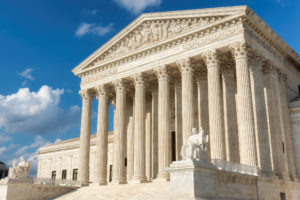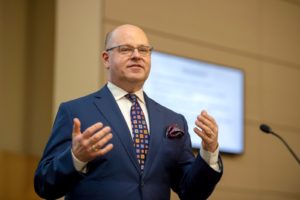Stanford Law School’s Mark Lemley Argues the Supreme Court is Making an Unprecedented Power Grab
The United States Supreme Court is engaged in behavior never before seen in American history argues Mark Lemley, the William H. Neukom Professor of Law, in a new Harvard Law Review article.
“Unlike previous shifts in the Court, this one isn’t marked by debates over federal versus state power, or congressional versus judicial power, or judicial activism versus restraint,” he writes in “The Imperial Supreme Court,” published November 20, 2022. “Nor is it marked by the triumph of one form of constitutional interpretation over another. On each of those axes, the Court’s recent opinions point in radically different directions.”
What the Court is doing, Lemley observes, is radical and new. Through its decisions over the last several years, it steadily has been restricting the power of Congress, administrative agencies, the states, and the lower federal courts—and concentrating power in itself. The Court is achieving this through a variety of theories and reinterpretations of long-standing precedent.
In analyzing what he calls “the era of the imperial Supreme Court,” Lemley notes that the Court’s power grab cannot be explained by a consistent judicial philosophy, nor is it necessarily even intentional. However, it is dangerous, he says, asserting that “we must consider more radical options to protect the American form of government.”
Professor Lemley discusses a few high points from his paper here.

When did it become clear to you that the Supreme Court was engaging not simply in traditional types of judicial activism or deference to certain judicial philosophies, but in something new: consolidating broader powers for itself? Was this a slow realization or a light bulb moment after a certain decision?
It has been a combination of things over the past two years. But the central points weren’t the big Constitutional law cases everyone talks about, like Dobbs, in which the Court overruled Roe v. Wade. It was seeing changes in the way the Court treats common law, equity, and appellate procedure that led me to conclude there was something bigger going on here.
Can you give an example?
Many expected the Court to overrule Chevron v. NRDC (a landmark 1984 case that gave deference to federal agencies) during its last term. But instead, in West Virginia v. EPA, the Court took an even more powerful step to limit agency power by holding that agencies can’t take action on anything the Court considers a “major question” without clear and explicit congressional approval. Adherence to a “major question” doctrine is ultimately something new, as Justice Elena Kagan notes in her dissent in the case, saying, “The Court has never even used the term ‘major questions doctrine’ before.” Machinations like this allow the Court to reject significant agency actions that are within their grant of power, but which the agency implements in ways the Court doesn’t like, such as the EPA’s efforts to restrict carbon emissions.
How do you foresee the “Imperial Supreme Court” wielding its power in the cases currently before it, where we expect decisions in the coming months?
I think the Court is poised to continue its path, dismantling important precedents that have been around for decades, like affirmative action in education. But I am somewhat encouraged by oral arguments on issues like the Environmental Protection Agency, in Sackett v. EPA, where conservative justices seemed to be looking for middle ground. I hope that is an indication that at least a few justices recognize the risks of a naked power grab.
On the other hand, the Court seems inclined to intrude in a significant way on states’ traditional powers in another case currently before it. In Moore v. Harper, the petitioners argue that state courts and executive officials have no power to apply state voting laws and constitutions and that the exclusive decision maker for federal elections must be state legislators. A decision for petitioners would be a remarkable intrusion on state legal process —essentially holding that Marbury v. Madison is federal law, but states are precluded from following it. It would present a real risk that the United States will no longer be permitted to hold democratic elections.

Was there no other time in American history where we saw the Court engaged in similar tactics?
There are certainly times in the past when the Court has been accused of pursuing an ideological agenda. But they have usually been doing it by siding with a group whose interests the justices are aligned with (federal over state power, or vice versa, individual rights versus government, or vice versa, Congress over the executive branch, or vice versa). What is new about this era is that there aren’t any clear winners in the Court except the views of the justices themselves.
What should be done about this new Supreme Court phenomenon? Can you illuminate some of the “radical fixes” you touch on in the latter part of your article?
I’m not optimistic about fixing this. I do think ideas like 18-year terms for justices would help, but adopting any fix requires a political consensus in Congress that we seem unlikely to achieve anytime soon. I do worry that if we don’t do something to rein in the Court the result may be a loss of respect for the rule of law more generally. And that would be catastrophic.
Mark Lemley is the William H. Neukom Professor of Law at Stanford Law School and the Director of the Stanford Program in Law, Science and Technology. He is also a Senior Fellow at the Stanford Institute for Economic Policy Research and is affiliated faculty in the Symbolic Systems program. He teaches intellectual property, patent law, trademark law, antitrust, the law of robotics and AI, video game law, and remedies. He is the author of nine books and 194 articles, including the two-volume treatise IP and Antitrust. His works have been cited nearly 300 times by courts, including 17 times by the United States Supreme Court, and more than 38,000 times in books and law review articles, making him the most-cited scholar in IP law and one of the ten most cited legal scholars of all time.
